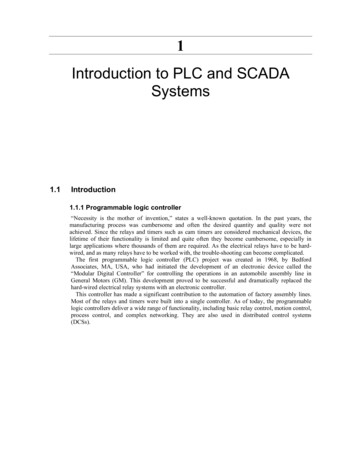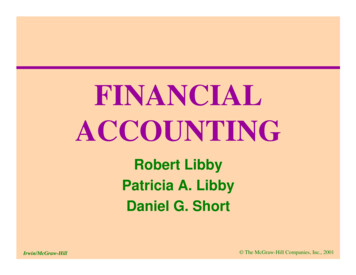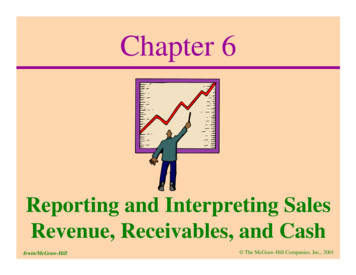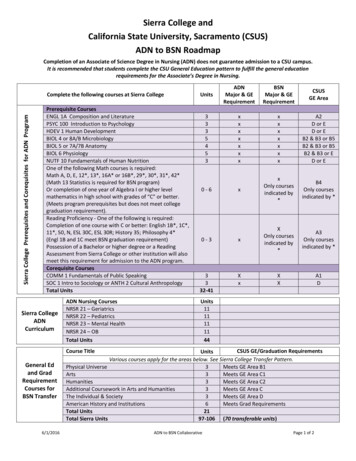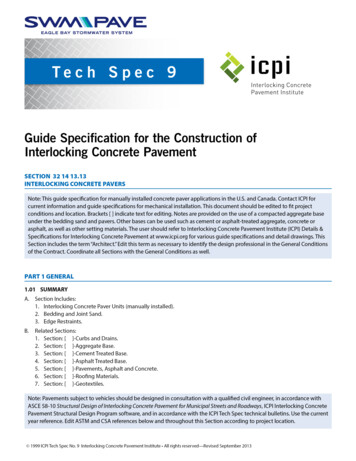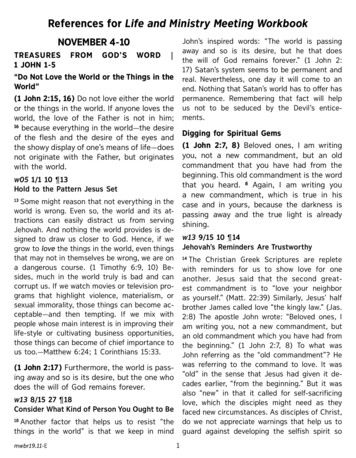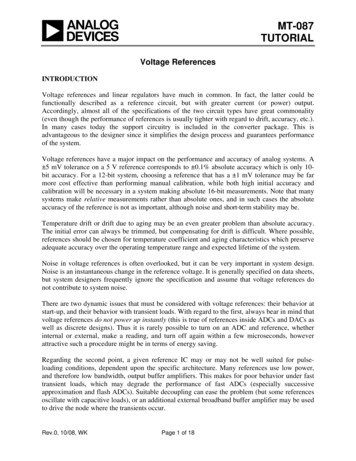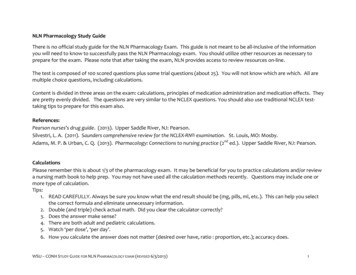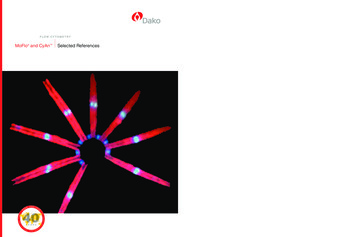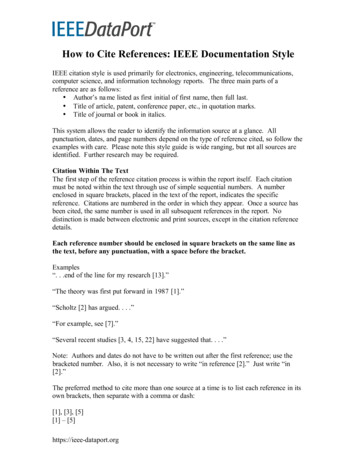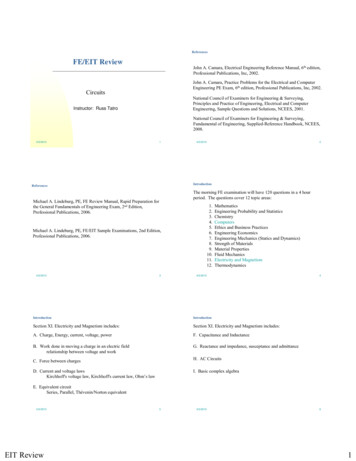
Transcription
ReferencesFE/EIT ReviewJohn A. Camara, Electrical Engineering Reference Manual, 6th edition,Professional Publications, Inc, 2002.John A. Camara, Practice Problems for the Electrical and ComputerEngineering PE Exam, 6th edition, Professional Publications, Inc, 2002.CircuitsNational Council of Examiners for Engineering & Surveying,Principles and Practice of Engineering, Electrical and ComputerEngineering, Sample Questions and Solutions, NCEES, 2001.Instructor: Russ TatroNational Council of Examiners for Engineering & Surveying,Fundamental of Engineering, Supplied-Reference Handbook, The morning FE examination will have 120 questions in a 4 hourperiod. The questions cover 12 topic areas:Michael A. Lindeburg, PE, FE Review Manual, Rapid Preparation forthe General Fundamentals of Engineering Exam, 2nd Edition,Professional Publications, 2006.1.2.3.4.5.6.7.8.9.10.11.12.Michael A. Lindeburg, PE, FE/EIT Sample Examinations, 2nd Edition,Professional Publications, 2006.4/5/201023MathematicsEngineering Probability and StatisticsChemistryComputersEthics and Business PracticesEngineering EconomicsEngineering Mechanics (Statics and Dynamics)Strength of MaterialsMaterial PropertiesFluid MechanicsElectricity and ctionSection XI. Electricity and Magnetism includes:Section XI. Electricity and Magnetism includes:A. Charge, Energy, current, voltage, powerF. Capacitance and InductanceB. Work done in moving a charge in an electric fieldrelationship between voltage and workG. Reactance and impedance, susceptance and admittance4H. AC CircuitsC. Force between chargesI. Basic complex algebraD. Current and voltage lawsKirchhoff's voltage law, Kirchhoff's current law, Ohm’s lawE. Equivalent circuitSeries, Parallel, Thévenin/Norton equivalent4/5/2010EIT Review54/5/201061
Scope of the SystemsUnitsYou will be expected to analyze Linear, Lumped parameter, timeinvariant systems.VoltThe Potential difference is the energy required to move a unitcharge (the electron) through an element (such as a resistor).Linear – response is proportional to V or I(no higher order terms needed)AmpLumped Parameter - Electrical effects happen instantaneously in thesystem. Low frequency or small size (about 1/10 of the wavelength).Electric current is the time rate of change of the charge, measuredin amperes (A).OhmThe resistance R of an element denotes its ability to resist the flowof electric current; it is measured in ohms (Ω).Time Invariant - The response of the circuit does NOT depend onwhen the input was applied.4/5/201074/5/20108UnitsAlgebra of Complex NumbersCoulombThe amount of charge that crosses a surface in one second when asteady current of one ampere flows.A complex number z, consists of the sum of real and imaginarynumbers.z a jbFaradCapacitance is the ratio of the charge on one plate of a capacitor tothe voltage difference between the two plates - measured in farads(F).The rectangular form can be found from a phasor with polarmagnitude c and an angle θ.a c cos θb c sin θz a jb c cos θ jc sin θHenryInductance is the property whereby an inductor exhibits oppositionto the charge of current flowing through it - measured in henrys(H).4/5/201094/5/201010Algebra of Complex NumbersAlgebra of Complex NumbersA complex number z, consists of the sum of real and imaginarynumbers.Add or subtract complex numbers in the rectangular form.z a jby c jdz a jbz y (a c) j (b d )The phasor form (polar) can be found from the rectangular form asfollows:Multiply or divide complex numbers in polar form.c a2 b2m b θ tan a 1z 〈θy 〈φ z〈 (θ φ )y b z c〈θ a 2 b 2 〈 tan 1 a 4/5/2010EIT Review114/5/2010122
Algebra of Complex NumbersExample - Algebra of Complex NumbersComplex numbers can also be expressed in exponential form by use ofEuler’s Identity.The rectangular form of a given complex number ise jθ cos θ j sin θWhat is the number when using trigonometric functions?The trigonometric functions then become:cos θ e jθ e jθ2sin θ e jθ e jθ2jz 3 j4D( A) 5e j 36.86( B) (5)(cos 36.86D j sin 36.86D )(C ) cos 0.64 j sin 0.64( D) (5)(cos 0.93 j sin 0.93)The correct answer is Electric charge is a fundamental property of subatomic particles.An electric field E with units of volts/meter is generated in the vicinityof an electric charge.A Coulomb equals a very large number of charged particles. Thisresults in a Farad also being a very large number of charged particles.Thus we usually deal with very small amount of charge.The force applied by the electric field E is defined as the electric flux ofa positive charged particle introduced into the electric field.F QEThe charge of one electron is -1.602 x 10-19 C.The work W performed on a moving charge QB a certain distance in afield created by charge QA is given byThe charge of one proton is 1.602 x 10-19 C.r2r2r1r1r2QQQAQBdr A B24πε4πεrr1W Q E dL F dr rk is performed only if the charges are moved closer or farther apart.Current is the movement of charge.For a uniform electric field (such as inside a capacitor), the work donein moving a charge parallel to the E field isW QΔVThe last equation says the work done is the charge times the change involtage the charge experienced by the movement.The electric field strength between two parallel plates with a potentialdifference V and separated by a distance d isE 4/5/2010EIT ReviewVd 1 1 r2 r1 By convention the current moves in a direction opposite to the flow ofelectrons.Current is measured in Amperes and is the time rate of change ofcharge.i (t ) dq(t )dtIf the rate of change in the charge is constant, the current can bewritten asI dQdtThe above equations largely describe the behavior of a capacitor.174/5/2010183
Magnetic FieldsPractice Problem - ElectrostaticsA magnetic field can exist only with two opposite and equal poles.Determine the magnitude of the electric field necessary to place a 1 N force on anelectron.While scientists have searched for a magnetic monopole it has not yetbeen found.A magnetic field induces a force on a stationary charge.Conversely a moving charge induces a magnetic field.F Q EThusE The magnetic field density is a vector quantity and given by BFQ 1N 6.24 10181.602 10 19 CNC 6.24 1018 VmφMagnetic FluxB AAreaAn inductor (or transformer) relies on the magnetic field interactionwith moving charges to alter the behavior of a circuit.4/5/2010194/5/2010Practice Problem - ElectrostaticsDC CircuitsA current of 10 A flows through a 1 mm diameter wire. What is the average numberof electrons per second that pass through a cross section of the wire?DC Circuits include the following topics:( A) 1.6 1018electronssec( B ) 6.2 1018electronssec(C ) 1.6 1019electronssec( D ) 6.3 101920DC VoltageResistivityResistors in Series and ParallelPower in a Resistive ElementCapacitorsInductorselectronssecCapacitors in Series and ParallelThe closest answer is D.4/5/2010214/5/201022DC CircuitsCircuit SymbolsElectrical Circuits contain active and passive elements.Active elements can generate electric energy – voltage sources, current sources, opampsPassive elements absorb or store electric energy – capacitor, inductor, resistor.An ideal voltage source supplies power at a constant voltage regardless of the currentthe external circuit demands.An ideal current source supplies power at a constant current regardless of the voltagethe external circuit demands.Dependent sources deliver voltage and current at levels determined by voltages orcurrents elsewhere in the circuit.4/5/2010EIT Review234/5/2010244
DC VoltageDC currentSymbol: V or E (electromotive force)Symbol: ACircuit usage: Vor v(t) when voltage may vary.Circuit usage: Ior i(t) when current may vary with time.Voltage is a measure of the DIFFERENCE in electrical potentialbetween two points.Amperage is a measure of the current flow past a point.Current THROUGH a circuit element.Voltage ACROSS two points.4/5/2010(Coulomb per second)254/5/201026ResistivityDefinitionsA Direct Current (dc) is a current whose polarity remains constant withtime. The amplitude is usually considered to remain constant.Symbol: R measured in ohms, ΩCircuit usage: RResistance is the property of a circuit or circuit element to opposecurrent flow.The amplitude is usually considered to remain constant.R ρAn Alternating Current (ac) is a current that varies with time.A common form of AC is the sinusoidal power delivered by the powercompany.4/5/201027Resistors in Series and ParallelLLength (resistivity )AAreaA circuit with zero resistance is a short circuit.A circuit with an infinite resistance is a open circuit.4/5/201028Example - Calculating equivalent resistanceSeries Resistors:Req R1 R2 Req ? 5 6 7 18ΩThe equivalent resistance REQ is larger than the largest resistor.Parallel Resistors:111 .Req R1 R2Req ?For Two Resistors in Parallel:Req 4/5/2010EIT ReviewR1 R2R1 R2 10(20) 200 3010 20 6.67ΩThe equivalent resistance REQ is smaller than the smallest resistor.294/5/2010305
Power in a Resistive ElementPassive Sign ConventionThe power dissipated across two terminals isUse a positive sign for the power when:Current is the direction of voltage drop.P ( ) VI ( )V2R ( ) I 2RP the power in wattsV the voltage in voltsI the current in amperesI.A.W. with the Passive Sign Convention (positive) – element is absorbing power.- (negative) – element is delivering power.4/5/201031Power - Example4/5/201032CapacitorsSymbol: F for capacitancePower delivered/absorbed.Circuit usage: C for capacitorC εAQ CVdCapacitor resists CHANGE in voltage across it.Passive charge storage by separation of charge - Electric field energy.P ( )2VR ( )dv1 tv(t ) i dτ v(t0 )dtC t0The total energy (in Joules) stored in a capacitor isi (t ) c( 5V ) 25V 1 Watt( )( )4100Ω100Ω2energy 4/5/201033CV 2 VQ Q 2 222C4/5/201034InductorsCapacitors and Inductors in Series and ParallelSymbol: H for HenriesCapacitors add in parallel (CAP)Circuit usage: L for inductorL NφICEQ C1 C2 C3 .Where N is the number of turns through a magneticflux φ which results from the current I.Use the following form for series capacitance.CEQ Inductor resists CHANGE in current thru it.LEQ L1 L2 L3 .1 ti (t ) v dτ i (t0 )L t0The total energy (in Joules) stored in an inductor isUse the following form for parallel inductors1LEQ 1 1L1 L2 .LI 2energy 24/5/2010EIT Review1 C12 .Inductors add in series (just like resistors)Passive energy storage by creation of magnetic field.div(t ) Ldt1C1354/5/2010366
Example - Calculating equivalent capacitanceExample - Calculating equivalent inductance (1 2 3) H 6 HLeq ?Ceq ? (1 2 3) μ F 6 μ FThe equivalent capacitance Ceq is larger than the largest capacitor.The equivalent inductance Leq is larger than the largest inductor.Leq ?Ceq ? 111μ F 2μ F 116 3 2 1μF6 1( )μF6 μ F 0.55μ F1111111 16 μF 1 13μ F1213The equivalent capacitance Ceq is smaller than the smallest capacitor.4/5/201037DC Circuits 11H1 21H 31H6H1116 3 2 16H 111 16 H 0.55 HThe equivalent inductance Leq is smaller than the smallest inductor.4/5/201038DC Circuit AnalysisDC Circuit Analysis include the following topics:Ohm’s LawKirchhoff's LawsShort Break – 5 minutesRules for Simple Resistive CircuitsSuperposition TheoremSuperposition MethodLoop-Current MethodNode-Voltage MethodSource EquivalentsMaximum Power TransferWe will also briefly look at RC and RL Transients4/5/201039Ohm’s LawOhms Law:4/5/201040DefinitionsV IRCircuit Connections:This version of Ohm’s Law assumes a linear circuit.R VIΩ VABranch – a connection between two elementsNodes – point of connection of two or more branches.Loops – any closed path (start/end same point) in a circuit.4/5/2010EIT Review414/5/2010427
Kirchhoff’s LawsRules for Resistive CircuitsKirchhoff’s Current Law – sum of all current equals zero.The current through a simple series circuit is the same in all circuitelements.sum of all currents in sum of all currents out.I I R1 I R2 I R3This is a restatement of conservation of charge. IinThe sum of all voltage drops across all elements is equal to theequivalent applied voltage. I outVEQ V1 V2 . IREQKirchhoff’s Voltage Law – sum of all voltages around a closed path iszero. V 0 V Vdropclosed pathrise4/5/2010434/5/201044Rules for Simple Resistive CircuitsRules for Simple Resistive CircuitsVoltage Divider for Series ResistorsCurrent Divider for Parallel Resistors:v1 R1R1v vREQR1 R2v2 R2R2v vREQR1 R24/5/2010i1 R2iR1 R2i2 45R1iR1 R24/5/201046Example – Current DividerExample - Voltage DividerFind i2Find voltage V2v2 vs4/5/2010EIT ReviewR2R1 R2 (10V )24 2 (10V )26 10V3 3.33Vi2 i474/5/2010R1R1 R2 (30mA)9k9k 18k (30mA)927 30mA3 10mA488
Superposition TheoremSuperposition Method1. Deactivate all independent sources except one.Voltage source zero when shorted.Determine the contribution (responses) of each independent source tothe variable in question.Then sum these responses to find the total response.Current source zero when opened.2. Solve the simplified circuit.3. Repeat until all independent sources are handled.The circuit must be linear to use superposition.4. Sum the individual responses to find the total response.4/5/201049Methods of Analysis4/5/201050Loop-Current MethodThe loop-current is also known as the mesh current method.Loop-Current Method – assign currents in a loop and then write thevoltages around a closed path (KVL).A mesh is a loop which does not contain any other loops within it.Assign mesh currents to all the (n) meshes.Node-Voltage Method – assign a reference voltage point and writecurrent as voltages and resistances at the node. (KCL).Apply KV
EIT Review 1 4/5/2010 1 FE/EIT Review Circuits Instructor: Russ Tatro 4/5/2010 2 References John A. Camara, Electrical Engineering Reference Manual, 6 th edition, Professional Publications, Inc, 2002. John A. Camara, Practice Problems for the Electrical and Computer Engineering PE Exam, 6th edition, Professional Publications, Inc, 2002. National Council of Examiners for Engineering & Surveying .
